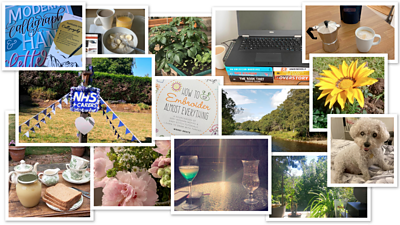
In March of 2020, in response to the Covid-19 pandemic, the UK government imposed social and physical distancing measures on the population. The lockdown caused significant changes to all aspects of daily life. During this time, we decided to adjust our work priorities to research how people’s lives and use of technology and media were changing under lockdown.
In this post, we explain why we decided to conduct this study and share and evaluate our methodology. You can read about our design process for the data postcard cultural probes in part two and our findings from the study in part three.
- ±«Óãtv R&D - Life under lockdown - capturing what people felt was important
- ±«Óãtv R&D - Life under lockdown - the value and role of technology and media in a pandemic
Why research people's lives during lockdown?
While the Covid-19 lockdown has impacted the whole country, we have not all been in the same boat. Class, race, living situation and financial situation have created stark differences in our experiences of the pandemic. For this reason, we wanted to shine a light on specific groups in society which we hypothesised would be more adversely affected by the situation.
We chose to run the study across the following three groups of people:
- 18-30 years old from low socio-economic groups, with high representation from BAME communities.
- Households with multiple generations under one roof: children, parents, grandparents, aunts/uncles.
- Vulnerable & isolated populations: those who were shielding for age or health reasons, people over 70, people with accessibility needs/disabilities, people living alone.
Although vastly different from 'normal' life, the lockdown provided a unique opportunity to understand people's relationship to the technology and media they consume, what it can replace from in-person experiences and what's impossible to replicate.
With the possibility of further national and localised lockdowns ahead, for potentially the next couple of years, we will all be increasingly reliant on technology to live out our lives, our values and realise the people we want to be.
We hope this research will spark ideas for how technology and media can provide some bridges and stepping-stones for people during these difficult times.
How we designed the study
Making the study engaging and fun
We wanted to track participants over a long period to understand how lockdown impacted their routines and how and where new habits were being adopted. We decided to run a four-week diary study so that we could chart changes in behaviour over time.
When it came to thinking about designing the study, our first concern was how to keep participants engaged and motivated for the four weeks. We tried to do this by making the study fun and interesting to participate in. We chose to incorporate , which is particularly good at building up a rich picture of people's habits, thoughts and values as well as eliciting inspirational data useful in the ideation phase.
To keep it exciting, we designed tasks that used different mediums and forms of engagement including letter writing, photo taking, video tours, and voice messages to their 'future selves'.
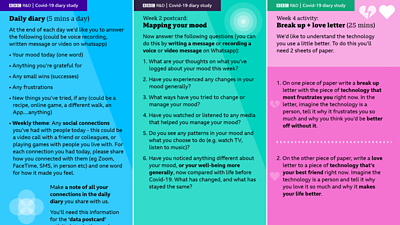
Examples of some of the tasks we sent out
Because of the pandemic, we weren't able to send probe packs to participants as might traditionally be done. Instead, we had to devise tasks we could send to participants via WhatsApp and that they could complete with whatever materials they had at home. Our only requirement was that participants had some basic stationery, pens and paper, at home to take part.
Building up a rich picture of everyday life under lockdown
Participants sent us a short daily diary five days a week. In this, we asked them to share things like their mood, what they're grateful for, frustrations, new habits, small wins. This was designed to let us build up a detailed picture of everyday life, and the ups and downs participants went through. It also served to create a regular rhythm to the project, established a trusting relationship with the researcher, and introduced some consistency in participant's lives at a time when structure and routine were missing.
Involving participants in the interpretation of their own data
In our team, we always try to research, ideate and prototype with users not for them. We wanted the study to be beneficial and interesting to participants, not just to us as researchers. So we tried to find ways that participants could actively reflect and interpret their data throughout the project. To do this, we drew inspiration from the , a project by and , and created a weekly task that involved participants collecting, hand-drawing and reflecting on their personal data.
We'll be blogging separately about this method and our evaluation of it soon.
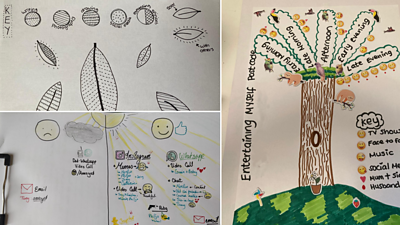
Examples of completed data postcards
Designing clear study instructions
From previous studies, we knew the importance of making task instructions clear and straightforward, particularly if they are to be done remotely. Participants should not feel like they're being tested, so the instructions should be concise and light in tone to keep them engaged. For this study, we sent all our instructions via WhatsApp, so we designed for this format, specifically as attached images in the messaging app.
The key things we had to consider were the length of copy and legibility. We went through many edits, each time testing on various devices, editing and simplifying the text. We aimed to fit most instructions onto one phone screen and certainly no more than two to minimize scrolling. With limited space, it was important the design had a clear layout with well-spaced sections and considered typography to emphasise legibility. We optimized this as best as we could, but as back up we also had the instructions in text form ready to send if required (fortunately no one requested this).
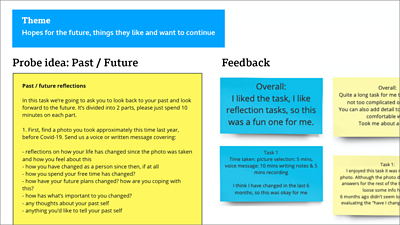
Design process: Detail of an idea and initial feedback
The study ran for four weeks, and each week we sent three sets of instructions - the daily diary/weekly theme, cultural probe and data postcard. To make each week distinct, we used different colours and designed graphics to emphasise the activities and icons to theme each week.
Reflecting on what worked and what didn't
What worked well
- Photograph-taking: During week one, participants were given a list of prompts and were asked to take photographs of things they associated with those prompts, for example, 'a new habit or hobby'. This task was really successful and helped to build a more detailed picture of participant's lives. The prompts we gave them were open and allowed for some creativity and freedom to interpret.
- Letter writing: In the final week of the study, we asked participants to write a love letter to a piece of technology they couldn't live without and a break-up letter to a piece of technology that was no longer serving them. We were surprised by how well this task went, mostly as it was the last week of the study. However, participants really embraced this task and wrote expressive, detailed letters that they evidently enjoyed writing. The letters themselves provided a unique insight into people's relationships to different technologies/products, how they impact their moods and what activities and behaviour they enable. In our analysis, we were able to identify values around technology usage that may not have emerged from a more straightforward task.
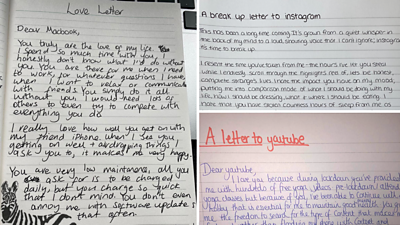
Love letters and break up letters
- Message to my future self: In week three, we asked participants to send a voice, video or written message to themselves a year from now. We asked them to include things like: what they wanted to remember from this time, anything they'd learnt about themselves, what they'd enjoyed and wanted to continue beyond lockdown. This task unearthed priorities and worries that hadn't come up in other tasks; the format of sending a message to themselves rather than the researcher seemed to mean participants opened up more.
- Data postcards: Participants enjoyed reflecting on their own data and found it interesting to see patterns in their own behaviour and reflect on changes etc. More about this method in a future blog post!
What didn't work so well
- Daily diaries: Although these did help us build a picture of day-to-day life, this task did get repetitive for participants. They commented that as they didn't have much on, they often felt they didn't have much to tell us, and it felt a bit repetitive as the study went on. We could have anticipated this and changed the questions we were asking more often.
- Video house tours: In week two, we asked participants to give us a video tour of their homes and talk about emotional associations they had with different areas of where they lived. However, this task proved to be too complicated, and once participants embarked on the video tour, they seemed to forget the questions we'd asked them to respond to. Most videos turned out to be literal house tours detailing how they used the space in a practical way. Proof that it's essential to keep tasks simple and easy to follow!
Final thoughts
This was a long study, and we're thankful to the participants for being fully engaged and for their great and often very candid responses. It was vital for us to build good relationships with them, to earn their trust, and this is a testament to the rich findings that emerged from the study. There are always lessons from this type of research, and we will continue to develop, evolve and improve methodologies and activities to find new ways to work with our audiences and to learn more from them.
- -
- ±«Óãtv R&D - Audience Research
- ±«Óãtv R&D - Life under lockdown - capturing what people felt was important
- ±«Óãtv R&D - Life under lockdown - the value and role of technology and media in a pandemic
- ±«Óãtv R&D - Digital Wellbeing
- ±«Óãtv R&D - Human Values: Understanding Audiences Beyond Demographics
- ±«Óãtv R&D - Psychometrics for Human Values: a new way to measure success and value
- ±«Óãtv R&D - Being Healthy & Safe: Human Value Priorities During a Pandemic
- ±«Óãtv R&D - Designed for Life: Understanding Memories and Wellbeing in a Digital World
- ±«Óãtv R&D - Designed for Life: Making a Creative Memory Study for Young People
-
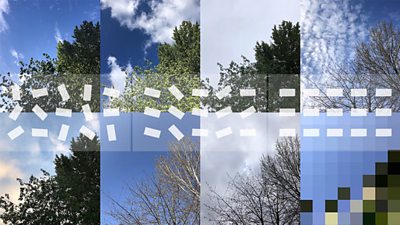
Internet Research and Future Services section
The Internet Research and Future Services section is an interdisciplinary team of researchers, technologists, designers, and data scientists who carry out original research to solve problems for the ±«Óãtv. Our work focuses on the intersection of audience needs and public service values, with digital media and machine learning. We develop research insights, prototypes and systems using experimental approaches and emerging technologies.

